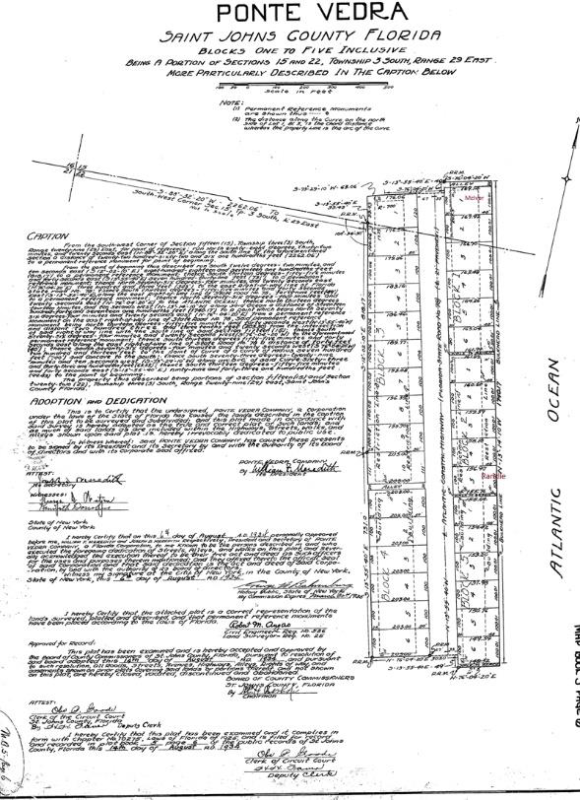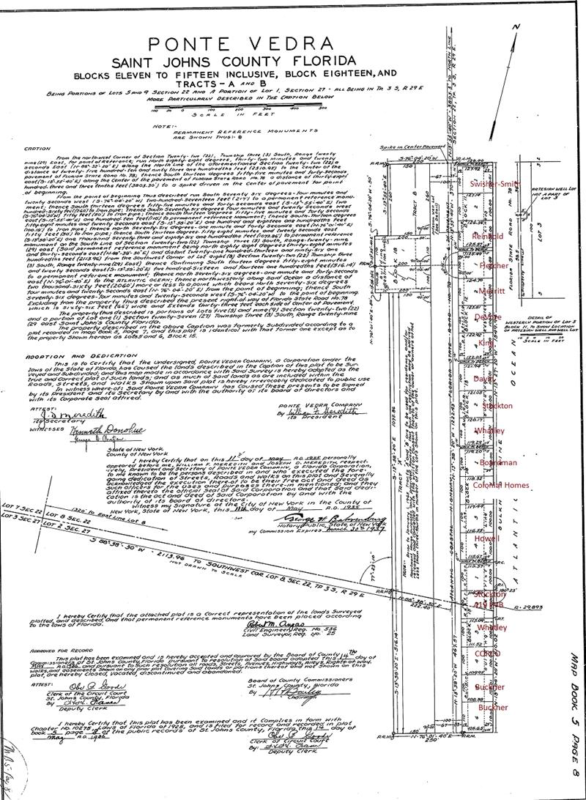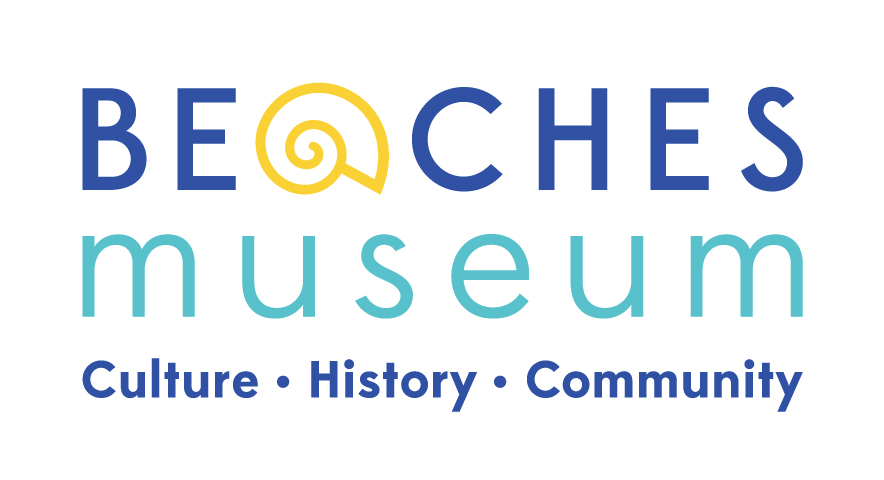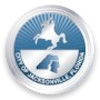Ponte Vedra Pioneers, 1934-40
By Don Mabry
Who were those brave people who risked money buying land on an isolated ocean front, a place that had once been a mining town called Mineral City but had been rebranded as Ponte Vedra? Few acquired lots in 1934-1940. After all, this was in the midst of the Great Depression. Early buyers set the course of development. Jack Pate, a retired Naval Captain, made a list of people and corporations who acquired those lots in Ponte Vedra Beach in 1934 and 1935. (See below).1 I decided to find out who else bought between 1934 and 1940, the last year that US census data is available. So, I scoured other sources to learn their names. What did these pioneers do in life that allowed them to spend money on such a non-essential? To find out, so I examined their biographical details to flesh out the names and draw a few conclusions.

Source: University of North Florida
The Telfair Stockton Company created Ponte Vedra Beach as an elite real estate development. The company had done it before when it had developed Riverside, Avondale, and the San Marco neighborhoods. In 1928, before there was a Ponte Vedra, Mineral City enjoyed a nine-hole golf course which was being expanded to eighteen holes and a three-story club house. The Stockton Company cleaned up the mining site, reshaped the golf course, and built tennis courts, a swimming pool, a private club, an inn, and other buildings to entice people to buy and build. Equally important, the company wanted to attract paying members and guests to its Ponte Vedra Club & Inn which it founded in 1937. Restrictive covenants and Club membership requirements guaranteed that not just anyone could leave in Ponte Vedra. It used deed restrictions to control who could live there. Only “whites” or “Caucasians” and their servants could live on the property. No horses, cattle, swine, roosters, or guineas were allowed nor advertisements. The lot could have only one residence and such outbuildings as a garage and servant’s quarters. The minimum cost of the residence was $2,500. In 1929, only 2.3% of families in the US had an income of over $10,000 and only 8% had income over $5,000. In 1941, the average annual income was $1,492. A copy of a deed is attached to this essay.
The land was sculptured by turning mining pits into lagoons, building roads that curved, and placing houses near the course to give the inhabitants peaceful vistas. That Ponte Vedra Beach was hard to reach was an advantage. One drove from Jacksonville on the winding Atlantic Boulevard (then call the beach road) east to the intersection of Atlantic and Neptune Beaches, then south through Neptune and Jacksonville Beaches to the St. Johns County line where one drove on the new road built by B. B. McCormick & Sons in 1928-29. You needed the desire and means to get there.
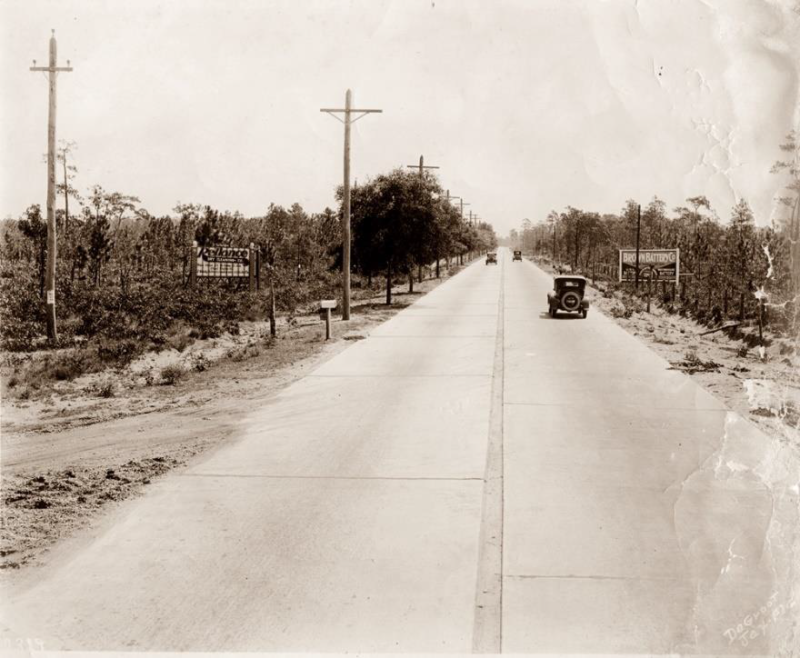
Telfair Stockton, born in Quincy, Florida on January 31, 1860, enjoyed enormous business success because he was ambitious and smart. He started work as a newsboy in 1876 and never looked back. His brothers were also successful men. They created and owned the Florida Times-Union for a time. Telfair sold lots in Pablo Beach for the Jacksonville & Atlantic Railroad and owned the ill-fated Jacksonville, Mayport, Pablo Railroad (see my I’ve been Working on the Railroad. He switched to real estate development in 1884, founding what became Telfair Stockton and Company. The Company became one of the largest and most prominent real estate developers in Florida.
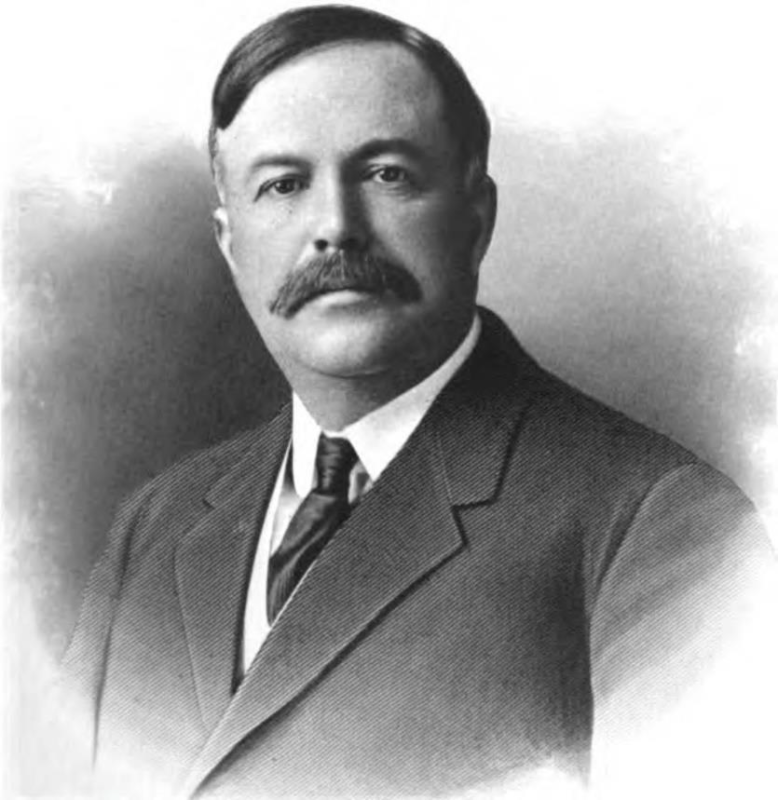
Telfair married Florence Fitch on January 15, 1885. Between them, they produced Florence Stockton, James Roosevelt, and Telfair, Junior. He served as President, of the Stockton-Budd Company and the New Springfield Company. He advocated government funding to deepen the Jacksonville harbor, to build jetties to channel the river’s mouth, to dredge the river, and to improve railway facilities and inland waterways. He served in public office, including election as state representative from Duval County in 1902, but had little interest in politics. Building nice neighborhoods intrigued him until his death on February 2, 1932. His son James Senior took up the reins.
James Roosevelt Stockton and his wife, Elizabeth Bryan Stockton, bought Lot 2, Block 15 (now 419 Ponte Vedra Boulevard) on May 22, 1935, a date when many deeds were recorded. I call it “Stockton Day.” The Company deeded lots to its members and encouraged them to build a house to show that Ponte Vedra was viable.
He was privileged from his birth in Jacksonville on December 31, 1893. His family enjoyed wealth, as one of the most prominent families in Jacksonville. In 1900, James was the middle child in the family home at 1060 Riverside Avenue. He had an eight year-old sister, Florence, and a five year-old brother, Telfair Junior. Riverside was a neighborhood for the well-to-do which attracted more moneyed people after the Great Fire of Jacksonville of 1901. Telfair Senior was prosperous enough to send James to Princeton University, a favorite of the Southern gentry. He graduated in 1916, and then he went to work as a salesman for his father’s real estate firm. He registered for the draft in 1917 and noted that he had served as an infantry private in a training camp in Plattsburgh, New York.
On November 22, 1919, at age 25, he married Harriet Louise Baker, age 19. Louise had grown up almost next door at 1065 Riverside Avenue. The Bakers family had moved to nearby May Street by the time Louise and James married. Her father was an owner of Baker & Holmes Company, dealers in wholesale groceries, grains and building materials. John Fletcher of Telfair Stockton would work for the company.
In July, 1924, the couple sailed to Europe on the S.S. America with his parents. They returned on the S.S. Leviathan from Cherbourg, France, arriving on September 22nd. Life was good, for very few families could take such a pleasure trip. Six years later, however, they divorced. In April, 1930, he was living with his parents, Telfair and Florence, and brother Telfair on Avondale Circle in a $100,000 house. She was living with her parents on Pine Street in a $45,000 house, not far from her sister-in-law Florence Stockton Rogers and her husband Frank. They bought a house and lot in Ponte Vedra. After all, Riverside and Avondale were then elite neighborhoods.
James, age 38, married Elizabeth Randolph Preston Bryan on May 21, 1932 in St. John’s Episcopal Cathedral in Jacksonville, Florida. She was 24, having been born on April 19, 1908. She gave birth to James Roosevelt Stockton, Jr., the future developer of Sawgrass Country Club, in 1933. He had taken command of the family business after his father died in February, 1932. By 1940, they had moved south of the St. Johns River to 909 Arbor Lane in the San Marco neighborhood, which his father, Brown Whatley, and Joe Davin had developed. James and Elizabeth had a big household: their sons, Preston and James Junior, and daughters Jeannette and Elsa plus his mother-in-law, sixty-three year old Elizabeth Ann Bryan.
It was his task to lead the creation of Ponte Vedra. It was his good fortune that the National Lead Company, sold the remainder of its land to the Telfair Stockton Company in 1942. He had the foresight to realize that, even though lots were hard to sell during World War II, it was a matter of time before it was worth a fortune.
The Buyers
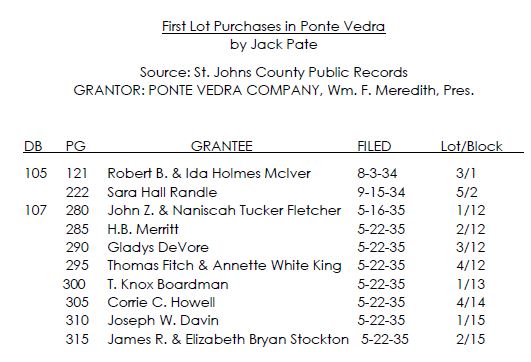
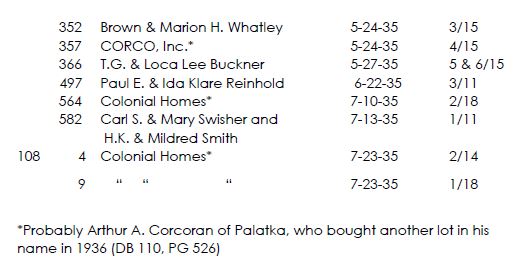
The brothers in charge of the Ponte Vedra Company were William Meredith and his brother Joseph, president and secretary, respectively. President Meredith was no greenhorn. He and his brother were New Jersey natives whose father was a stockbroker. William graduated from Princeton University. He worked for his father after his college graduation for a few years but then went out on his own. In 1906, he organized the Titanium Alloy Manufacturing Company and then the Titanium Pigment Company in Niagara Falls, New York. Both companies were absorbed by the National Lead Company in the 1920s. He and his brother Joseph D. Meredith reorganized Buckman & Pritchard into the Ponte Vedra Company in 1934 for the Telfair Stockton Company.
Robert Boyd McIver, M. D. and Ida A. Holmes McIver took the plunge and bought the first lot (Block 1, Lot 3,) on August 3, 1934. (See the deed below). It was an oceanfront lot, of course, bounded on the west by State Road 78, which became State Highway A1A, and is now Ponte Vedra Boulevard. He was an excellent pioneer because he was a very well respected physician whose presence in Ponte Vedra would inspire confidence. Four other physicians followed his lead by 1938.
McIver was born in Spartanburg, South Carolina on April 19, 1892, but the family migrated to Savannah, Georgia by 1910. He returned to Spartanburg to attend Wofford College and earned his A. B. degree in 1912. He earned his medical degree from Jefferson Medical College in Philadelphia, Pennsylvania on June 3, 1916. He was popular among his classmates.
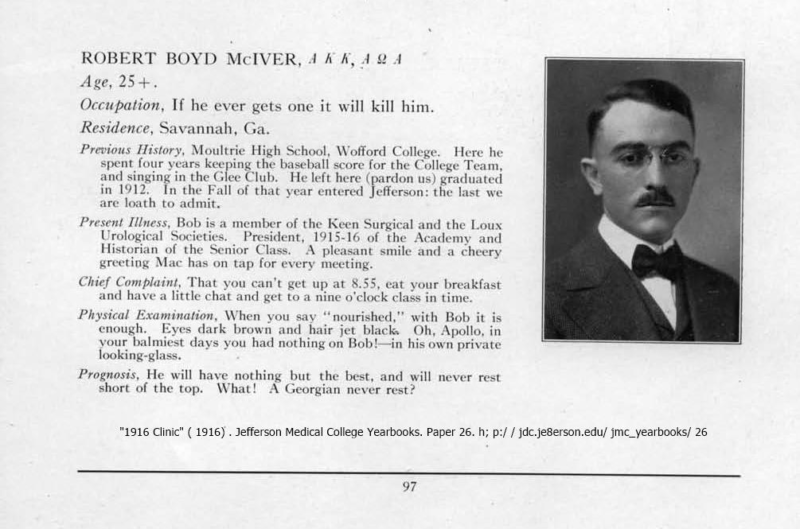
On his application to Duval County (Florida) Medical Society in 1920, he wrote that he was a Resident Physician in Pennsylvania and then served as a Captain, U. S. Army Medical Corps for 18 months. He served during WWII as chief of medical defense in Duval County. Florida licensed him to practice on December 3, 1919. He began his practice in Jacksonville in 1920. He described himself as a General Practitioner with an office at 425 St. James Building and a residence at 2207 Post Street in the Riverside neighborhood of Jacksonville. He founded the Jacksonville Blood Bank, was elected presidents of medical societies, and was honored in 1965 with a Certificate of Merit by the Florida Medical Association. Urology interested him as a medical student and he resumed that interest in Jacksonville.
On September 3, 1929, he married a Floridian, twenty-five year old Ida A. Holmes of South Jacksonville. Her family lived in San Marco. Their son, John Klob McIver was born in 1931; their daughter, Laurina McIver, was born in 1933. They had five grandchildren.
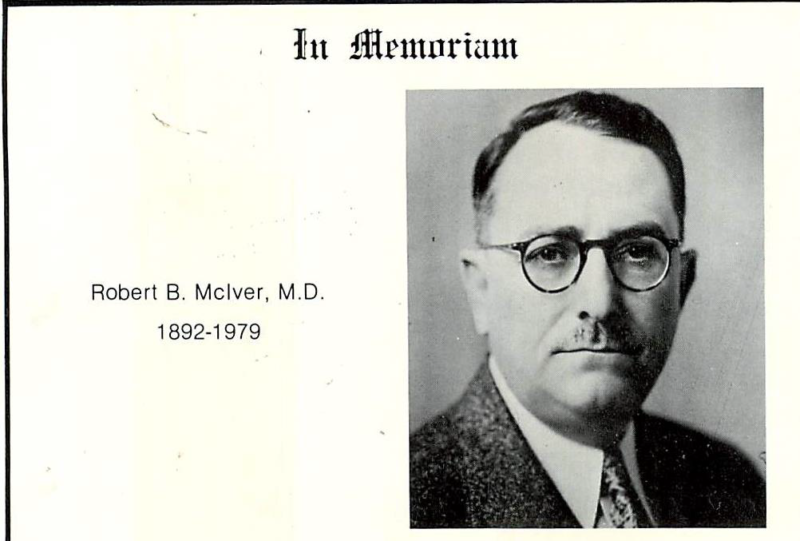
Sara Hall Randle pioneered in the development of Ponte Vedra when she bought a lot on September 15, 1934. She was a married woman living in Waycross, Georgia but she bought in her own name. She and her husband, John Richard Randle, owned the Ware Hotel in Waycross, Georgia. Jack, as her husband was called, managed the Ware since the prominent seven-story downtown hotel opened in February, 1929. In the early days of selling lots, Telfair Stockton Company sold almost exclusively to Jacksonville people.

Sara Hall was a New England Yankee, born on March 9, 1889 in Boston, Massachusetts, but like so many Yankees the family migrated to Florida. By 1900, they lived in Tallahassee. Her father, Thomas H. Hall, was a successful farmer who supported a wife Mary, four children, a governess, and a farm worker. He provided well for his household. Sara, still single at 29, went to Great Britain and France in November, 1918 for the American Red Cross.
Sara’s life changed in 1921 when she married John Richard Randle, a widower. She was 32; he was 38. Jack was born in Webster County, Mississippi on November 16, 1883. He worked on the family farm but, became manager of the Leon Hotel in Tallahassee by 1918. He married his first wife, Carrie Bonnie Burnham, on April 5, 1914 in Tallahassee, but she died on October 30, 1919 at age 35.
The Leon Hotel there, according to Florida Memory, was “located on the north side of Park Avenue between Monroe and Adams. This was the site of the first courthouse (1833-79), first Leon Hotel (1882-1885), second Leon Hotel built in 1885 and burned in 1925, and post office beginning 1935.”

He became manager of the newly-built Ware Hotel in Waycross, Georgia in 1929. The couple lived in the hotel. Somehow or other, they learned that lots were being sold in the new development, Ponte Vedra Beach and she bought one in her name in late summer 1934.
She took over the hotel after Jack died on February 6, 1935 at age 55. She continued to go to Jacksonville, for she died in Duval County in December, 1955. She was buried in the Bonaventure Cemetery, Savannah, Georgia where she had laid her husband to rest. She didn’t build a house in the 1934-40 period.
__________________________________________________________________________

Many members of the Stockton Company acquired lots in 1935, starting with John Fletcher and his wife on May 16, 1935. John Zabud Fletcher was born in Havana, Gadsden County, Florida on May 10, 1897. Havana, in the midst of tobacco farms, offered too little economic opportunity so he moved the two hundred miles east to Jacksonville. In June, 1918, Fletcher was working for Baker & Holmes Company, owned by James Stockton’s father-in-law. His life trajectory was a little different from some others of the group. He lived at 2742 Hubbard Street on the north side of Jacksonville but moved to Orlando, fell in love with beautiful twenty-three year old Mildred Sloan Baker, and married her on May 3, 1924. She bore him two sons, John and Jerome. They divorced in 1929, the same year he left the insurance and real estate business in Orlando and joined Telfair Stockton Company. She went on to become a famous Broadway actress. He rose to the position of Vice President of Telfair Stockton & Company. Fletcher, age 37, and Naniscah Tucker, age 22, married on February 21, 1935. A few months later, they bought the Ponte Vedra Beach lot and built a home there.
They had two sons, Tucker in 1937 and Paul in 1938. Naniscah died on June 10, 1944 while saving the lives of her sons who had gotten caught in a run out in the ocean in front of the Reinhold house next door. The current was sweeping them out to sea from the slough in which they had been playing. People tried to save all of them but only the boys were saved. Naniscah did, managing to keep their heads above water until rescuers reached them with a boat. She, however, drowned; she was thirty-four.
Fletcher left Telfair Stockton on June 29, 1936 to form John Z. Fletcher and Associates, Inc. on June 29, 1936. It handled “all lines of fire, casualty and surety-specializing in the handling of complete coverage for trucking and bus transportation firms.” He dissolved it in September, 1943. He had a number of business interests during the rest of his life.

Courtesy: Beaches Museum
Henry Bryant Merritt, a Telfair Stockton vice president in 1935 and president in 1940, acquired his deed on May 22, 1935. He built a house at 517 Ponte Vedra Boulevard.
Born in New England in 1889, he was a member of the Ribault Club of Jacksonville Florida in 1929-1930 and is identified in its membership list as part of Telfair Stockton, the only member listed as such. Many of the other members came from big cities of the East Coast of the United States. In short, membership was selective. The Club was a winter recreational venue with a two-story club house on Fort George Island. There they could swim, play tennis and golf, sail yachts, and party. The Great Depression on the 1930s killed it. Merritt belonged to other prestigious organizations such as the Florida Yacht Club, Jacksonville.
By the time of the 1940 census, he had married Mary E. Merritt. His seventy-three year old mother, Alice, lived with them as well as two servants, Andy and Juanita Jones. They lived in an $8,000 house on Barrs Terrace in Jacksonville and used the Ponte Vedra house as an escape from the city.
Gladys C. DeVore bought the lot that became 515 Ponte Vedra Boulevard on May 22, 1935; her husband, William Luther DeVore, was a manager at Telfair Stockton.
Gladys Nell Cathcart saw the light of day in Plymouth, Iowa on June 19, 1894 but her father, a Methodist preacher, moved the six of them to Staples Village, Minnesota. They had a teenage girl of Swedish extraction as a servant. They were not poor.
William Luther DeVore was born August 15, 1884 in Ninety-Six, South Carolina. When he registered for the draft n 1918, he was a bachelor who worked as Chief Deputy Clerk in the Federal court and lived in the St. Albans Hotel. He listed his mother in Ninety-Six, South Carolina as his next of kin.
When Gladys was twenty-six, she married Bill DeVore on May 5, 1921 in Marion, Iowa.
By 1930, Bill, Gladys, daughters Gladys and Louise, and his mother-in-law lived in a $15,000 house on Avondale Avenue. He was a rental agent for the Telfair Stockton Company. Ten years later, Bill was a manager.
Their two daughters married well in life and became involved in civic affairs in Jacksonville. Dorothy was born in 1922. She married Harry T. Platt, Jr. on August 30, 1947. He was a successful Pontiac dealer. Louise “Beezie”, born 1926, married Charles D. Towers, Jr. on June 2, 1950. He was a prominent lawyer.

Courtesy: Beaches Museum
The Kings, Thomas and Annette, were naturals for building a beach house. He managed construction for Telfair Stockton. The deed for Lot 4, Block 12 was theirs on May 22, 1935, the day of the big buy. Their house address became 513 Pont Vedra Boulevard.
Thomas Fitch King, Sr. was born in Jacksonville on December 25, 1906. His father was manager of a wholesale confectioner. The family of four plus two servants lived well on Riverside Avenue. His father died in September, 1919 when Tom was 13. In 1920, he lived with his widowed mother, two brothers, a sister, an uncle, and a cousin on Post Street in Riverside.
King and White married on June 28, 1933 in Jacksonville. He was working for Telfair Stockton Company and still living on Riverside Avenue. Annette Mallette White born January 21, 1909 in Lumber City, Georgia. She was part of the last graduating class of Duval High School, the only high school for white people. She went on to graduate from Wesleyan College in Macon. She helped found the Southside Presbyterian Church. As with so many Stockton wives, she was active in church and civic affairs. By 1940, they were living in San Marco not far from other Stockton people.
Knox Boardman, an immigrant, was Treasurer of Telfair Stockton Company when he acquired his lot on “Stockton Day.” He had immigrated to the United States from Northern Ireland in 1905. He was born there on December 13, 1884. Five years later, he married Cora Jolly; the young couple were still dependent on her father, a railroad roadmaster, for they and their daughter lived with his family in 1910 at 1840 Hill Street (near the western approach to the Matthews Bridge). Boardman liked working with numbers. He had was a bookkeeper for a fertilizer company. By 1918, he was an accountant for the Cummer Lumber Company. By the 1930s, Boardman was Treasurer of Telfair Stockton and living on Avondale Avenue near Belvedere Avenue, a favorite neighborhood for Telfair Stockton executives.
So T. Knox Boardman and Cora could enjoy the fruits of their labors. They built a beach house in Ponte Vedra Beach. They were able to help Lewis Augustine, a company bookkeeper. By 1945, he would be the corporate secretary of Telfair Stockton, continuing in that capacity for Stockton, Whatley, & Davin, Inc. and its subsidiary corporations in 1946. He worked from their offices in the Atlantic National Bank Building.
Corrie C. Howell, a divorcee, acquired her lot May 22, 1935 but never built a house on it. She and J. Clement Howe, a lawyer, divorced in 1934 after thirteen years of marriage. In 1935, he moved into the St. Cloud Hotel in Jacksonville while she moved to Lake City.
Joseph W. Davin, the son of an immigrant, bought his lot on “Stockton Day.” He and Brown Whatley, who also bought a lot, formed Davin, Whatley & Company in 1937. Davin was born on March 15, 1902 in Hoboken, New Jersey. He was just finishing his civil engineering degree from Rensselaer Political Institute in Troy, New York when he took a Mediterranean cruise with Thomas Cook & Company in 1923. His father, an Irish architect, had an excellent practice!
Davin moved to Jacksonville in 1924, obtaining work with civil engineer Robert Angas, the man who did the engineering for the creation of Ponte Vedra Beach. In 1929, he became a sales agent for Telfair Stockton & Company; he had a room in a house on May Street. In the early 1930s, he became the head of Telfair Stockton’s building and development operations. He was one of the three major developers of San Marcos. Its Little Theatre (now Theatre Jacksonville) was a pet project. He ended his bachelor life when he married Lillian Shinholser Jones, a divorcee, on January 2, 1941. He was 38, she 36. Their two witnesses were Brown and Marian Whatley. The newlyweds built a five bedroom home on the St. Johns River at 903 River Oaks Road in San Marcos. Lillian was born in 1904 in Sanford, Florida. Her father was a railroad engineer. She married Earle E. Jones, a young Jacksonville newspaper editor, on October 22, 1926; the marriage ended in 1935.
Joe Davin was very active in civic affairs and the arts. He was President of the Meninak Club in 1952. He was on the board of Jacksonville University and the Children’s Home Society. Davin was very active in professional societies. On January 19, 1965, he was one of twenty-two men who signed a manifesto in favor of consolidating all the governments of Duval County into one and asking the state legislature to pass an enabling act allowing county voters to vote on it. He died on March 3, 1987.
Brown Lee Whatley and his wife, Marion, acquired a lot next to the Stockton on May 24, 1935. The professional and personal relationship that led to the formation of Stockton, Whatley, and Davin existed in the early 1930s.
Whatley was born on March 19, 1900 in Ashland, Alabama to a father who was in the real estate business in the Birmingham area. His family could afford to educate him at the Riverside Military Academy in Gainesville, Georgia, 1917-1919, the Art Institute of Chicago, 1919-1920, the Art Students League of New York, 1920-1921, and the University of Georgia. He had helped pay his way by working in the summer. In 1918, he was living in LaGrange, Georgia and working as hotel clerk in Columbus. Georgia. He, Joe Davin, and Telfair Stockton developed the San Marco area in the 1920s and 1930s. In 1937, he and Davin built the Little Theatre. They developed the Alexandria Place part of the San Marco.
By the time he was thirty, he had married Marion Harlan on June 4, 1924, and was working in real estate advertising. The couple and their two children, Brown Junior and Marion (called Muffett) were living near San Marco Boulevard with their servant. They moved to River Road in San Marco near other Telfair Stockton executives by 1935. He had become a partner and Vice President of Telfair Stockton.
When Stockton, Whatley, and Davis was formed in 1946, he was selected as President, a position he held until 1960. He became President of Arvida Realty Sales Inc. He formed the Mortgage Bankers Association of Florida, August 1, 1952; he was elected as President of the Mortgage Bankers of America in October of that year. The mortgage bankers association remained dear to his heart. He and Marion died in an automobile accident in 1982 as they drove an annual meeting in Ponte Vedra Beach. Gone was civic leader at the local, state, and national levels.
When Thaddeus Gaston (known as T. G.) and Loca Lee Buckner acquired two lots on May 27, 1935, the Telfair Stockton Company brought a Jacksonville power couple onto the scene. Significantly, the lots were on the same Block where the Stocktons, Whatley, and Davins owned lots. The Buckners were Coca-Cola bottling plant owners not only in Jacksonville but also Miami.
T. G. Buckner was born in Granville, South Carolina on March 5, 1888. In part, he was named after his father, Gaston, a lawyer. In time, his mother, Eva, bore two other sons, one of whom would eventually work for T.G. In 1910, T. G. was boarding in the Gordon home on West Adams Street in Jacksonville. He was 23 and an agent for a news company, perhaps its bookkeeper. He married Martha “Mattie” Lanier, a Georgian. Their daughter Sara was born September 20, 1911. They left Jacksonville for Miami by 1917, for he was then Secretary-Treasurer of the Miami Coca-Cola Bottling Company. He stayed in Miami until he and Mattie divorced in 1927. Mattie stayed in Miami; he would move to Jacksonville where he would be President of the Jacksonville Coca-Cola Company from 1923 until 1940.
T. G. married Loca Lee Cason in Macclenny west of Jacksonville on January 12, 1928. She was fifteen years younger than he, having been born about 1903. In 1930, he and Loca Lee lived on San Jose Boulevard with his two children. He was President of the Jacksonville/Florida Coca Cola Company.

Courtesy: Florida Memory
When he died on October 13, 1941, Loca Lee took his place as a Coca-Cola executive. She moved to Miami and became the President of the Miami Coca-Cola Bottling Company, 1947-63. She endowed the Loca Lee Buckner Theatre at Florida Southern College in Lakeland among her other philanthropies.

Source: Paul E. and Klare N. Foundation
http://www.reinhold.net/aboutus.php
Paul Ernest Reinhold was one of five children of immigrants, His father arrived from Germany in 1882; his mother three years later. He was the second child (his only sister preceded him by four years; he was born on May 13, 1894 in Verona, Pennsylvania near Pittsburgh. His father owned his own bakery.
In 1916, the year he turned twenty-two, he married Ida Klare Neely on his birthday and founded Reinhold Ice Cream Company in Oakmont, Pennsylvania, a twin borough with Verona.
He was a good businessman for he sold his ice cream to a large customer base and built the first ice cream manufacturing plant in 1930, One innovation was its use of artificial refrigeration. He pioneered in ice cream manufacturing machinery. Ice cream eaters owe him a debt of gratitude.
His success meant he could provide well for his family. In 1930, he lived in the Oakmont Borough in Allegheny County, Pennsylvania. They lived in an ample house that was valued at $16,000. Yet, he was only 35 and Ida was 34.
Their daughters, twelve year old Anne and ten year old June, enjoyed the family servant, Thelma Bytheway, who was 18. He had family and friends living near. Life could only get better and it did.
J. C. Penney of department store fame contacted him in 1931. In 1926, Penney had created Penney Farms in Clay County, Florida near Jacksonville as an experimental farming community. The farm had a large dairy. Unfortunately, the stock market crash of 1929 and the subsequent economic depression forced Penney to focus on creating a retirement place for Protestant ministers, like his father. He persuaded Reinhold to come to Florida to make a dairy and ice cream business. Foremost Dairies was named after Penney’s prize bull. When Reinhold took over Foremost, in 1931, the company generated $1million dollars in sales; in 1955, it sold $400 hundred million worth and was third largest dairy company in the world. According to the Reinhold Corporation web site (http://www.reinholdcorp.com/aboutus.htm):
“Shortly after moving to Jacksonville, Mr. Reinhold also acquired the significant Clay County land holdings of retailer J.C. Penney. Originally, the land was used to support milking cows and cattle, and grow timber. Over the next twenty years, he sold significant acreage to the U.S. Government to establish Camp Blanding, and to the Gilman Paper Company, among others. Today, the remaining land currently supports the Corporation’s timber operations and the Shadowlawn Nursery.”
In June, 1935, he and Ida acquired what became 505 Ponte Vedra Boulevard while living in Avondale near both the St. Johns and Ortega Rivers.
Before he died on August 31, 1987 at age ninety-three, Reinhold was very active in business, civic, and philanthropic affairs. He served as honorary chair of the McKesson Corporation and a director of Eastern Airlines, Barnett Bank, and the American Heritage Life Insurance Company of which he was a founder. He helped the Jacksonville Boys’ Home, St. Luke’s Hospital, the American Cancer Society, and the American Red Cross Volunteer Life Guard Corp in Jacksonville Beach. In 1954, he and Klare created the Paul E. and Klare N. Foundation to help Clay County, Florida. These were only some of his contributions.
On July 13, 1935, two couples, Carl Southwick Swisher and his wife Mary G., and H. K. Smith and his wife Mildred, acquired one lot. They were Swisher Cigar partners, but Carl owned most of the company.

Swisher was born in Newark, Ohio on August 2, 1891 and lived there until he moved to Florida in 1924. After attending Doane Academy in Burlington, New Jersey, he matriculated at Denison University in nearby Granville where Elizabeth Trembley caught his eye and they married on August 7, 1912 in Newark. Their son, Herbert, was born in September, 1915. He served as Partner and General Manager of the family business, a cigar factory. Newark was the home of more than a dozen cigar factories but the Swisher firm was the most important. Carl’s paternal grandfather had received it as payment of a debt in 1861 and peddling cigars and other goods from wagons. Business was good and Carl’s father and uncle bought the business in 1881and named it Swisher Brothers. By 1909, Swisher Brothers was selling 300,000 cigars a day. John Swisher bought out his brother Harry and brought his son Carl into the business, renaming it John Swisher & Son in 1913. Newlywed Carl was 22.
The marriage did not last but she was treated well in the divorce. She raised their son Herbert in Newark, Ohio in a house which was valued at $10,000 in the 1930 census. After Herbert was grown and gone, she established the Elizabeth Trembley Swisher Scholarship at Denison. Herbert was buried in the family plot Jacksonville in 1990.
Carl moved the headquarters of John Swisher & Son to Jacksonville and mechanized cigar production. The Jacksonville plant was so successful that he closed the Ohio plants (which relied on hand labor) and consolidated them into the Florida plant. The Jacksonville operation was extremely successful. Its King Edward cigar became the best seller in the world. Later, Swisher Sweets grabbed a large part of the international cigar market.
He married again, this time to a nurse, Mary G. Wagner, in Cleveland, Ohio on July 29, 1927. It lasted ten years. They divorced in 1937. Carl married Leah G. Swann in St. Petersburg on December 18, 1937.
Carl’s family lived in a $60,000 home in 1930 on Old Mitchell Place near San Jose Boulevard in Mandarin. He was thirty-eight years-old; Mary was eleven years younger. They had a live-in nurse-governess for their two year old daughter, Martha. His father and family lived next door. Five years later, the family was living at 933 River Road in San Marco. His father and mother lived at 967 River Road. Telfair Stockton & Company did well selling lots to River Road residents!
Carl Swisher spent some of his money helping others. He joined the Jacksonville University (then Jacksonville Junior College) Board of Trustees in 1943 and served until 1962, being chair of the board from 1947-1961. Through his charitable foundation, he built a library, gymnasium, Swisher Auditorium, and two other buildings on the campus. After his wife died, he built the Leah G. Swisher Science Building in 1958. He also gave money for the Swisher Library at Bethune-Cookman University in Daytona Beach, Florida. He gave his support to the Bolles School. The Little Theatre, the Jacksonville Symphony and Friday Musicale. He helped Stetson University in Deland and St. Barnard College in Cullman, Alabama.
He was an avid contract bridge player, so much so that he authored and self-published Bridge, Its Language and Logic in 1947, a 38 page booklet.
Harold Kenneth and Mildred Worthington Smith, the lot co-owners, were born in Ohio. He came into the world in Ashland on May 26, 1891. She was born in Springfield on April 3, 1893. They married when in their early twenties on October 3, 1914 in Miami, Ohio. Her father, Lamar, was an accountant for a publishing company. In 1917, Harold was president of the H, K. Smith Company in Columbus, Ohio. He owned two stores, one sold gifts geared to Ohio State University students, the other clothing, The Smith had one daughter. Eventually, they would also have two sons as well.
In 1930, he was sales manager of the Swisher cigar factory in Jacksonville. By 1935, they had moved to 1044 River Road near the Swishers. By then, he was “owner” [partner] of the cigar factory. He retired while in his early fifties.
Smith and Swisher were members of the Jacksonville Hyde Park Golf Club in 1929-30. In 1934, both were honorary members of Ye Mystic Revellers, a select Mardi Gras group in Jacksonville. They were neighbors as well as Swisher cigar executives. Smith created the $500,000 Harold K. Smith Playhouse Endowment to be used for facility maintenance for Theatre Jacksonville. It has supported renovations of the Harold K. Smith Playhouse.
Pate’s list of First Lot Owners contains the names of two Florida corporation, CORCO and Colonial Homes, which he thinks might have been owned by Arthur A. Corcoran. CORCO was incorporated on March 21, 931 and dissolved on January 3, 1942; Colonial Homes was incorporated on December 24, 1934 and dissolved on February 14, 1941. The Florida Department of State’s Division of Corporations’ Web site (sunbiz.org) shows no owners. CORCO acquired its deed to Lot 4, Block 15 on May 25, 1935. That lot lies between the one own by Whatley and the two owned by Buckner. The Whatley property was 533 Ponte Vedra Boulevard; the CORCO lot would be 535. Neil McGuinness in his The Beaches: A History and Tour quotes Bill Hamilton (a Whatley nephew) as remembering the owner of 535 to be Olin E. Watts, a director of Telfair Stockton Company. Of course, Watts may not have been the first owner but he had a Ponte Vedra Beach telephone in 1938. Colonial Homes acquired Lot 2, Block 18 on July 10, 1935, and Lot 1, Block 18 and Lot 2, Block 14 on July 23, 1935. Howell had the deed for Lot 4, Block 18. Either of these corporations could have been owned by Corcoran or both. A corporation might have acquired on or more lots to build for a specific client or on speculation.
Arthur Adams Corcoran of Palatka bought a lot in Ponte Vedra Beach in 1936 to build his beach house. For years, he and his family owned a large riverfront house in Palatka, where he enjoyed a very successful career with Cypress Lumber Company. After he bought the beach lot, he retired and moved to the Ortega section of Jacksonville. He was a Michigander, born in Saginaw on June 20, 1885. His father was a lumberman and he would be as well. He graduated from the local high school and then went to the University of Michigan to earn two degrees, a Bachelor degree in 1904, a law degree in1907. He stayed in Michigan for a few years, working in the lumber business and then practicing law in Detroit with the firm of Tarseney and Fitzpatrick. He moved to Florida shortly after 1910. He served in the US Navy during World War One. He was an officer of Wilson Cypress Company, a very large enterprise, serving as its secretary, and then general manager. The Corcorans were mainstays of Palatka civic affairs, typical for wealthy businessmen. In 1940, he, his wife, and two daughters lived in a $20,000 home in Palatka on Sunny Point on the Johns River.
The Corcorans were friends of Marjorie Kennan Rawlings who first book South Moon Under (1933) mentions Palatka and the Wilson Cypress Company. The family moved to Jacksonville after 1940, enjoying a beautiful home on Ortega Boulevard. He retired early so he became very active in Jacksonville’s prominent social clubs.
Olin Ethredge Watts was born in Polk County, Florida on August 27, 1889. He graduated from the University of Florida law school and was admitted to the Florida Bar on March 1, 1928. Two years later, he, his wife and daughter lived in a $10,000 home at 3571 Richmond Street in Avondale. It was near Pine Street where other lot owner lived or had lived. He was an attorney in general practice. As with some others, he moved River Road. By then, they had another daughter and a son. A Ponte Vedra beach house was ideal for his family. He probably did legal work for the Stockton Company and knew its executives.
He, too, was a member of Ye Mystic Revellers. For the 1935-36 term, he was President of the University of Florida Alumni Association. He served as the first President of the Jacksonville Symphony Association in 1949. In January, 1959, Watts was appointed to chair a citizen’s committee that would advise City officials on the planning and construction of the proposed auditorium. Throughout his career, he was very active in the America Bar Association, chairing its Legal Education Committee in 1964.
Fred Tappan Woolverton (called Fred) bought a lot and built a home in 1936. He was born November 16, 1899 in Mount Vernon, NY to Samuel Woolverton, a bank president in Scarsdale, New York. This was a well-to-do family in Westchester County, a wealthy county abutting New York City. Fred had a privileged life growing up. When he registered for the draft in September, 1918, he noted that he had some training in the “Naval Service” while there. He went to Princeton University, graduating in 1922. He applied for a passport on August 24, 1922. He embarked on the Empress of China to do a year’s Presbyterian mission work in China teaching English and coaching baseball. In 1923, the twenty-three year old returned from Yokohama, Japan via the President Lincoln on August 8, 1923 having left Japan on July 26th. He married Margaret Wolf on January18, 1929 in Manhattan, New York City. She was also a New Yorker. He took his twenty-for year old bride to Bermuda for their honeymoon and then back home to 222 Grandview Avenue, White Plains in Westchester County, New York. They had a Belgian born twenty-five year old female servant, Alphonsine Veirman. He was doing very well for a man who had just turned 29.
They lived comfortably in White Plains, New York in a $21,000 home in 1930. He was an accountant for an automobile dealership. In 1935, they moved to Jacksonville where he established a Chevrolet dealership which became an Oldsmobile dealership in 1939. Jim Stockton, a fellow Princeton alum, persuaded Woolverton to move to Ponte Vedra Beach in 1936, selling him a lot for fifty dollars. He was the first permanent resident of the new community and worked hard to make it a community. They liked Ponte Vedra–its sparse population, its wildness, its social graces, and its collection of like-minded people. He promoted the settlement in the Princeton Weekly as early as 1938. His business, the Jacksonville Oldsmobile franchise, made him prosperous. They educated their three sons, Fred Junior, Robert, and William in northern prep schools and universities. Bobby graduated from his dad’s alma mater, Princeton.
Sidney Johnston in his Historic Properties Survey of St. Johns County, Florida mentions other early owners, but “early” is not dated. They are Asheleigh S. and Nathalie Moses of Millstone, New Jersey whom he says bought 423 Ponte Vedra Boulevard, Jessie Ball, a DuPont heiress, Vance Dykers, Wambolt Paulk, Paul F. Rheinhold, Carl Swisher, Russell Wells, and Joseph Davin. The only two from the Pate list were Reinhold and Davin. Asheleigh Strudevick Moses, born August 30, 1880 in St. Louis, Missouri, was a mechanical engineer for the National Lead Company in New York City in1917. He married Nathalie there in 1925. In 1930, they lived in St. Louis where he was an executive with a pigment manufacturer (probably National Lead or one of its companies). He and Nathalie were living in Ponte Vedra Beach when they returned from Australia on June 10, 1940 but their names are not in the 1938 telephone directory nor the 1940 census for Ponte Vedra. Neither is the name of Jessie Ball. She may have built or bought a home after 1940. Vance Dykers, a married woman, born in Georgia in 1899, lived on Riverside Avenue in Jacksonville in 1935; in 1940, she and her family lived on 1792 Edgewood Avenue in a $10,000 house. Her husband. John, was general manager of a life insurance company. Wambolt Paulk lived at 1709 Edgewood Avenue in Jacksonville with his wife and daughter in 1940. He was an automobile jobber, selling parts to repair shops. My efforts to find information about Russell Wells failed. Nevertheless, he was not on the Pate List, the telephone directory, or the Ponte Vedra census.
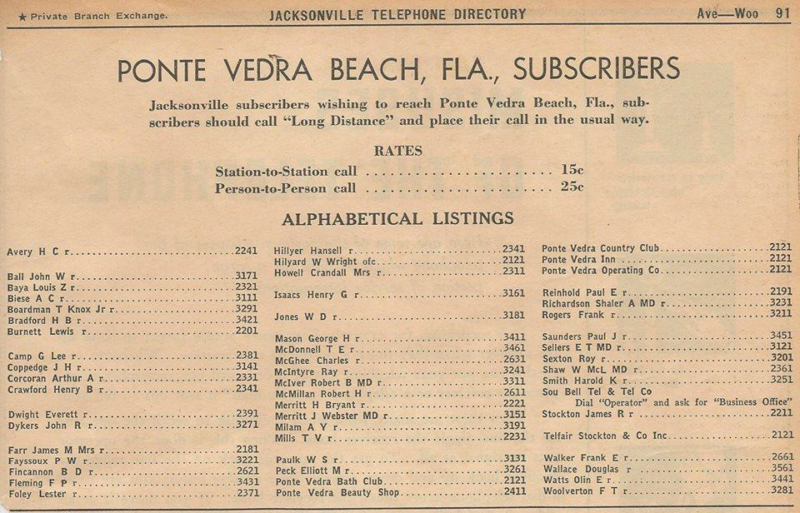
The Ponte Vedra section of the 1938 Jacksonville Telephone Directory provides information about houses or apartments with telephones. Having a telephone did not mean that the owner resided there; some resided in Jacksonville but had a telephone in the beach house. So, the directory shows telephone owners but not residents. It also shows the telephone numbers of the few businesses such as the Ponte Vedra Inn and Country Club, an institution created in 1937.


Few of the “telephone people” are found in the 1940 US Census for Ponte Vedra. The data show the residents, but I only show the heads of households, not all the residents.

Courtesy: Beaches Museum
The 1940 US Census for Ponte Vedra Beach shows only twelve heads of households as owners and eight as renters. Most did not live in Ponte Vedra Beach per se but nearby. Of the people examined in this essay, only Sellers and Woolverton are listed as owners. By 1940, the others had their primary residence elsewhere, probably Jacksonville. In addition to these two, the owners included Henry Carrere, a stockbroker; D. Grant Donaldson, Manager of General Motors; George Hermin, a retiree; Charles Holditch, a retiree; Roy Landrum, Jr., a service station owner; Charles Sabin, a retiree; E. Eugene Sims, who owned investments; A. Allen Walker; sales manager for a distillery; and Francis Waterhouse, a Jacksonville Junior College professor. Renters included W. Davis Armstrong, sales manager of Young’s Rubber, Inc.; R. Eugene Compton, service station manager; Roy F. Davis, hotel steward; Roy Landrum, Sr., golf greens foreman; Charles Layman, retiree; William K. Wayman, foreman, Ford dealership; James Wilson, deputy sheriff; and Deborah Wise. There is also an added page (81A) that lists Mrs. Frank Rogers, proprietor of the Inn’s gift shop, and Joe Errolsino, an Italian born lodger from New York who was a lodger at the Inn.
The United States entered World War II in December, 1941, slowing down the development of Ponte Vedra Beach. National Lead sold its holding to Telfair Stockton Company at a discount in 1942 because it was not earning enough profit. After the war ended in 1945 and Stockton, Whatley, and Davin was formed, development picked up.

Courtesy: Beaches Museum
Conclusions
Without the decision of the executives of the Telfair Stockton Company to acquire lots and build houses and to call upon friends to do the same, Ponte Vedra beach would have developed much more slowly. The company was able to attract wealthy people, mostly from Jacksonville, to build a beach house there. Permanent resident homeowners were rare by 1940. Ponte Vedra Beach was also an expensive resort; the Ponte Vedra Club and Inn, which its owner, the Telfair Stockton Company, founded in 1937, provided recreation for residents and for tourists. Profits could increase as more people, locals and tourists. Some guests would buy property.
In 1934-40, very few lot owners had attended prestigious schools such as Princeton. They had attended Rensselaer Political Institute, Denison University, Wofford College, St. Barnard College, Wesleyan College, and Florida State College for Women.
Most early lot owners were immigrants and sons of immigrants, that is, people born outside of the United States as well as people born outside Florida. The latter were common since much of Florida’s population had come from other states. Those who had one or more parents immigrating to the United States or had themselves were Boardman. Davin, and Reinhold. Immigrants tend to be ambitious; they had “get up and go”.
Divorce touched the lives of Stockton, Fletcher, Howell, Connie, Davin (his wife was a divorcee, Buckner, and Swisher (twice).
The Telfair Stockton people tended to cluster in Riverside, Avondale, and San Marco and then in Ponte Vedra Beach.
In 1940, the US census reveals only two permanent residents, Sellers and Woolverton, among the lot owners; the others had “beach houses”. In looking at that census, one has to remember that it covers the Palm Valley; so would the 1945 Florida State Census. Most of the heads of households were people who provided service to the others.
No wonder National Lead cut its losses in 1942 and sold it property to the Telfair Stockton Company. The locals did not depend upon Ponte Vedra for their livelihood; they had beach houses and a club to enjoy while they waited for better times.
_____________________________________________________________________________
ACKNOWLEDGEMENTS
No work such as this one can be done without help. The Beaches Museum and History Park archives are indispensable. Sarah Jackson, archivist, gives me help when I ask for it. Taryn Rodríguez-Boette and Elsie Oishi of the Jacksonville Historical Society aided me. Special thanks go to Chuck Riley, CAD Technician, St. Johns County Land Management Systems, St. Augustine, Florida. My neighbor and friend Edwin Ellis did some genealogical research for me. Tom Ravoo gave me valuable insights. Nath Doughtie and Walter Bennett make my research trips to the Beaches more enjoyable. Janet Macdonell read the manuscript and made valuable suggestions. As always my wife Paula gave me loving support.
SOURCES
In the course of this research, I consulted birth, marriage, and death records, the 1917-18 Draft Registration records, US Census of the United States, Florida State Census, passport applications, and passenger Lists of various ports by searching www.familysearch.org. I used Find A Grave (www.findagrave.com) and the Division of Corporations, Florida Department of State site. sunbiz.org. Florida Memory (floridamemory.com) was useful. With the generous and indispensable help of Charles Riley, CAD Technician, I was able to get documents, such as deeds and plat maps, from the St. Johns County Land Management Systems in St. Augustine, Florida. The archives of the Beaches Museum & History Park were indispensable.
“1916 Clinic” (1916).Jefferson Medical College Yearbooks. Paper 26. h; p://jdc.jefferson.edu/jmc_yearbooks/26.
“50 years ago this week,” Financial News & Daily Record, January 26, 2009.
“50 years ago this week,” Financial News & Daily Record, July 4, 2011. http://tinyurl.com/jzkwt6v.
“Alexandria Park,” Recreation and Community Services, City of Jacksonville. http://apps2.coj.net/parksinternet/parkdetails.asp?parkid=294.
“Annette White King,” obituary, Florida Times-Union, (from May 22 to May 25, 2006).
“Bethune-Cookman University’s Library is named after Carl Southwick Swisher,” Bethune-Cookman University. http://www.cookman.edu/academics/library/about/Swisher.html.
“Brown L. Whatley,” Wikipedia, https://en.wikipedia.org/wiki/Brown_L._Whatley.
“Cigar giant’s beginnings rooted in Licking County,” New Ark Advocate, June 30, 2008.
“Contributions to St. Luke’s Hospital Jacksonville Florida,” Whiteway Corner, http://tinyurl.com/zg3cbs3.
“Extraordinary Development Begins on the South Side of Jacksonville Beach,” Beach Life (June 29, 1928.
“Florida Yacht Club Jacksonville, Florida 1929-1930,” Whiteway Corner, http://www.whitewayrealty.com/Home/florida-yacht-club-1929-1930.
“Foremost Dairy Founder Paul E. Reinhold Dies,” Florida Times-Union, 1987.
“Foremost Dairy Products Incorporated,” Bizapedia.com.
“History,” San Marco Preservation Society. http://smpsjax.com/san-marco/history/.
“Marion Harlan Whatley,” Obituary, Florida Times-Union, January 26, 2014.
“Membership Application of Robert B. McIver.” circa 1920, DCMS [Duval County Medical Society], August-September, 1979.
“Membership Roll of the Florida Historical Society,” The Florida Historical Society Quarterly, Vol. 8, No. 4 (Apr., 1930), pp. 222-234.
“Olin E. Watts,” ABA Journal, November 1965.
“Past Presidents,” The Meninak Club of Jacksonville, November, 2009. http://www.meninak.org/about-meninak/past-presidents.html.
“Paul E. Reinhold,” Obituary, New York Times, September 3, 1987.
“Penney Farms, Florida,” Wikipedia.
“Photography: Palatka, Florida’s ‘Sunnypoint’- 1930’s,” http://www.aquilaarts.com/oldortega_gallery_sunnypoint.html.
“Ponte Vedra Beach Company,” Florida Department of State, Division of Corporations, sunbiz.org.
“Ponte Vedra Company,” Florida Department of State, Division of Corporations, sunbiz.org.
“Ponte Vedra Corporation,” Florida Department of State, Division of Corporations, sunbiz.org.
“Ponte Vedra,” Jacksonville Telephone Directory, 1938, p. 91.
“Review of Legal Education, Section of Legal Education and Admissions to the Bar, American Bar Association, Fall, 1964.
“Robert B. McIver,” Obituary. DCMS [Duval County Medical Society], August-September, 1979.
“Stockton Company,” Florida Department of State, Division of Corporations, sunbiz.org.
“Stockton, Whatley, Davin & Company,” Wikipedia, http://tinyurl.com/jf8fn65.
“Swisher Cigars,” CIGAR HISTORY 1916-1962 Machine Age. http://cigarhistory.info/Cigar_History/History_1916-1962.html.
“Swisher International Group,” Wikipedia, https://en.wikipedia.org/wiki/Swisher_International_Group.
“Telfair Stockton & Company, Inc.,” Bizapedia.com.
“Telfair Stockton & Company, Inc.,” Florida Department of State, Division of Corporations, sunbiz.org.
“The Ribault Club Jacksonville Florida 1929-1930,” Whiteway Corner. http://www.whitewayrealty.com/Home/ribault-club.
“University of Florida Alumni Association Past Presidents,” http://connect.ufalumni.ufl.edu/about/governance/past-presidents.
“Woolverton, Robert Dwight”. Obituary, Florida Times-Union. January 11, 2014. http://tinyurl.com/jxxmqm2.
“Ye Mystic Revellers Jacksonville Florida,” Whiteway Corners, http://www.whitewayrealty.com/Home/ye-mystic-revellers.
Blue and Grey, Robert E. Lee High School, Jacksonville, Florida
Bonner, Robert F., “Mildred Sloan Baker Copeland,” Find A Grave.Bulletin, Florida State College for Women, 1915.
Caldwell, B., Makers of America: An Historical and Biographical Work by an Able Corps of Writers, Volume 2 (Jacksonville: Florida Historical Society, 1909), 336-337.
Catalogue of the Florida State College for Women, 1915, p. 126.
Clark, Margaret, “Fletcher,” Ponte Vedra Recorder, November 11, 1996.
Descendants of William Fletcher I, Genealogy.com, http://www.genealogy.com/ftm/v/a/u/Kelly-L-Vaughn/GENE1-0014.html.
FitzRoy, Maggie, “The lifeguard chronicles,” Jacksonville.com, October 29, 2005.
FitzRoy, Maggie, “When Ponte Vedra was just a rural beach,” Shorelines, May 31, 2007.
FitzRoy, Maggie, and Beaches Museum & History Park, Ponte Vedra Beach. Images of America.
Florida Memory, https://www.floridamemory.com/items/show/24769.
Jacksonville Soft Drink Company Homepage, http://www.ca-yd.com/html/jaxcomp/jaxcomps.htm.
Johnston, Sidney, Historic Properties Survey of St. Johns County, Florida. Jacksonville, Environmental Services, Inc. 2001.
Johnston, Sidney. The Historic Architectural Resources of the Beaches Area: A Study of Atlantic Beach, Jacksonville Beach, and Neptune Beach, Florida. Jacksonville, FL: Environmental Services, Inc., July, 2003.
Kerr, Jessie-Lynne, “Yates’ call to meet made history,” Jacksonville.com, September 28, 2008.
Koehl, Elaine, The Ponte Vedra Club: The First Fifty-Five Years, 1927-1982. Ponte Vedra Beach, Ponte Vedra Club, 1982.
Mabry, Donald J. I’ve Been Working on the Railroad. HTA Books, 2012. http://historicaltextarchive.com/books.php?action=nextpre&bid=74.
Mabry, Donald J., “Beach Builder: B. B. McCormick,” HTA, http://www.historicaltextarchive.com/sections.php?action=read&artid=791.
Mabry, Donald J., Turning Sand into Gold,” HTA, 2016. http://historicaltextarchive.com/sections.php?action=read&artid=801.
Mabry, Donald J., World’s Finest Beach (2006). http://historicaltextarchive.com/books.php?action=nextpre&bid=70.
Mabry, Donald J., World’s Finest Beach: A Brief History of the Jacksonville Beaches (Charleston and London: The History Press, (2010).
Makers of America: An Historical and Biographical Work by an Able Corps of Writers. Jacksonville, FL: Florida Historical Society, A. B. Caldwell, 1909.
McCarthy, Kevin M., The Book Lover’s Guide to Florida, Tampa, Pineapple Press, 1992.
McGuinness, Neil, The Beaches: A History and Tour. Atlantic Beach, McGuinness Financial Corporation, 2010.
Men of the South. New Orleans, Southern Biographical Association, 1922.
Mortgage Bankers Association History, 2012.
Palatka News & Advertiser, April 14, 1916.
Paul E. and Klare N. Reinhold Foundation. http://reinhold.net/index.php.
Pearce, Mimi, “Joseph W. Davin Instrumental in the Early Development of San Marco,” San Marco Times, Spring, 2012.
Ponte Vedra Country Club, Jacksonville Beach Florida. 1935. Pamphlet. 10pp.
Ponte Vedra Club, Membership Information, 1948.
Price, Kevin, “82-year old Hotel Gets New Life in Waycross,” Jacksonville.com. July 16, 2011. http://jacksonville.com/news/georgia/2011-01-16/story/82-year-old-hotel-gets-new-life-waycross#.
Princeton Alumni Weekly, Vol. 39 (1938), p. 841.
Princeton Alumni Weekly, Vol. 94 (1993), p. 40.
Report of the Secretary of State of the State of Florida. For the Period Beginning January 1, 1933, and Ending December 31, 1934.
Robinson, Maurice J., Hidden History of Ponte Vedra. Charleston, The History Press, 2012.
Robinson, Maurice J., Ponte Vedra Beach: A History. Charleston, The History Press, 2008.
St. Petersburg Times, May 11, 1951, p. 50.
The Lincoln Star, Lincoln, Nebraska.
The Michigan Alumnus, Vol. 16, 1910.
The New York Lumber Trade Journal, Volume 87 (1929).
The Southern Lumberman, Volume 187 (1953).
Weaver, Paul L., The King’s and Pablo Roads, Florida’s First Highways. St. Augustine, Historic Property Associates, Inc., July, 2009.
Whittington, R.P., “Ponte Vedra’s Oldies, but Goodies,” Jacksonville Homes Magazine (March 2009)
Wood, Wayne, Jacksonville’s Architectural Heritage. Gainesville, University of Florida Press, 1996.
DEED




PLATS 1-5, 11-15
Block 18 is not shown.
Plat maps courtesy of Charles Riley, St. Johns County Land Management Systems in St. Augustine, Florida
